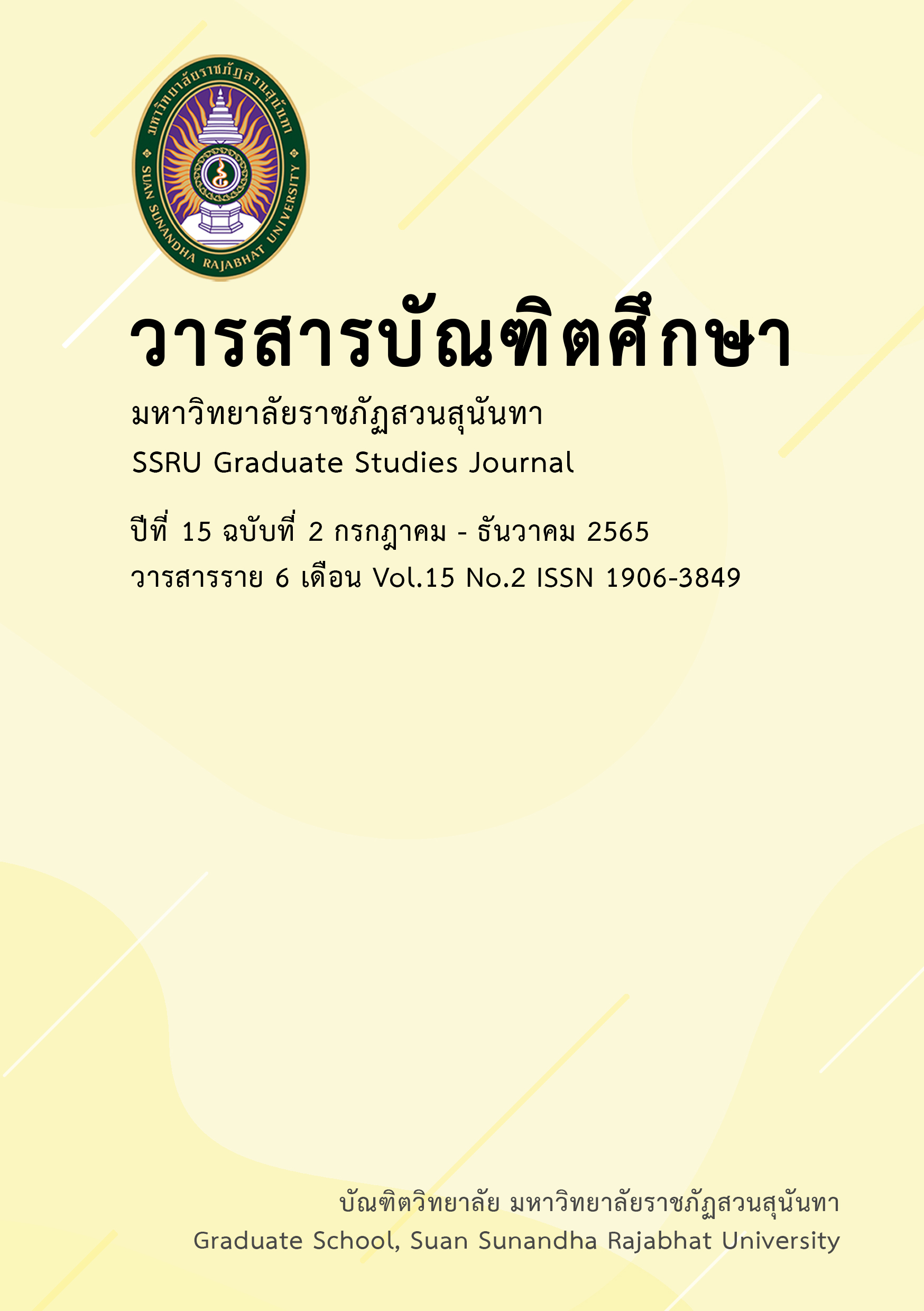นวัตกรรมทางการตลาด การจัดการโลจิสติกส์เชิงบูรณาการกับประสิทธิภาพการส่งออกกล้วยไม้ไทย
Main Article Content
บทคัดย่อ
ประเทศไทยเป็นศูนย์กลางการผลิตกล้วยไม้เขตร้อนของโลก อย่างไรก็ตาม ในปัจจุบันมีคู่แข่งรายใหม่เข้ามามีส่วนแบ่งทางการตลาดใหม่ส่งออกกล้วยไม้คุณภาพของไทยเป็นจำนวนมาก ซึ่งมีผลกระทบต่อการเพิ่มมูลค่าการส่งออก การวิจัยมีวัตถุประสงค์ ดังนี้ 1) เพื่อศึกษาสภาพปัจจุบันของการส่งออกกล้วยไม้ไทย 2) เพื่อศึกษาอิทธิพลของนวัตกรรมทางการตลาดและการจัดการโลจิสติกส์เชิงบูรณาการที่มีผลต่อประสิทธิภาพการส่งออกกล้วยไม้ไทย และ 3) เพื่อสร้างรูปแบบความสำเร็จในการส่งออกกล้วยไม้ไทย งานวิจัยนี้ใช้วิธีวิจัยแบบผสมผสานระหว่างการวิจัยเชิงปริมาณและเชิงคุณภาพ ในการวิจัยเชิงปริมาณ กลุ่มตัวอย่าง คือ ผู้บริหารระดับสูง และผู้บริหารระดับกลางของบริษัทผู้ส่งออกกล้วยไม้ซึ่งเป็นกิจการที่อยู่ในกลุ่ม SME ตามนิยามการจำแนกธุรกิจของสำนักงานส่งเสริมวิสาหกิจขนาดกลางและขนาดย่อม จำนวน 340 คน ขนาดของกลุ่มตัวอย่างใช้เกณฑ์ 20 เท่าของตัวแปรสังเกต ใช้วิธีการสุ่มตัวอย่างแบบหลายขั้นตอน ใช้แบบสอบถามในการเก็บข้อมูล วิเคราะห์ข้อมูลด้วยสมการโครงสร้าง ส่วนการวิจัยเชิงคุณภาพใช้วิธีการสัมภาษณ์เจาะลึก กลุ่มเป้าหมาย คือ เจ้าของสวนกล้วยไม้ ผู้บริหารของบริษัทส่งออก ผู้บริหารสมาคมที่เกี่ยวข้องกับการส่งออกกล้วยไม้ไทย ผู้บริหารบริษัทจัดการขนส่งสินค้าระหว่างประเทศ และผู้เชี่ยวชาญด้านการจัดการโลจิสติกส์ รวมเป็นผู้ให้ข้อมูลหลักทั้งหมด 20 ท่าน ผลการวิจัยพบว่า 1) สภาพปัจจุบันของการส่งออกกล้วยไม้ส่วนใหญ่ก่อตั้งมามากกว่า 5 ปีขึ้นไป มีจำนวนพนักงานไม่เกิน 50 คน มียอดส่งออกประมาณ 1-10 ล้านบาท บริษัทส่วนใหญ่ติดต่อซื้อกล้วยไม้กับสวนกล้วยไม้ไม่เกิน 50 สวน ส่งออก 1 – 10 ประเทศ ประเทศที่ส่งออกไปมากที่สุด คือ สาธารณรัฐประชาชนจีน รองลงมาคือ ประเทศสหรัฐอเมริกา 2) อิทธิพลของนวัตกรรมทางการตลาด การจัดการโลจิสติกส์เชิงบูรณาการ สามารถร่วมกันทำนายประสิทธิภาพการส่งออกกล้วยไม้ไทย (EXEFF) ได้ร้อยละ 86 3) รูปแบบความสำเร็จในการส่งออกกล้วยไม้ไทย ผู้วิจัยพัฒนารูปแบบขึ้นมีชื่อว่า COTS (C = Customer O = Orientation C = Collaboration T = Trust S = Satisfaction) สามารถนำไปเพื่อประยุกต์ใช้เป็นแนวทางในการส่งเสริมความสำเร็จให้กับผู้ประกอบการส่งออกในธุรกิจอื่น ๆ ตามตัวแปรที่ค้นพบ นอกจากนี้ ผลการวิจัยเชิงคุณภาพ ยังพบว่า รูปแบบการเสริมสร้างความสำเร็จของการส่งออกกล้วยไม้ไทย เป็นประโยชน์ต่อองค์กรภาครัฐและภาคเอกชนเห็นถึงความสัมพันธ์และรูปแบบแนวทางของนวัตกรรมทางการตลาด การจัดการโลจิสติกส์เชิงบูรณาการ ในอันที่จะส่งผลต่อประสิทธิภาพการส่งออกกล้วยไม้ไทย นอกจากนี้ยังสามารถเป็นแหล่งข้อมูลทางวิชาการสำหรับผู้สนใจ นักวิจัย เพื่อนําไปใช้เสนอแนะปรับปรุงพัฒนาการส่งออกสินค้าที่อยู่ในกลุ่มประเภทเดียวกันได้
Article Details
เอกสารอ้างอิง
Aulakh, P.S., & Kotabe, M. (1997). Antecedents and performance implications of channel integration in foreign markets. Journal of International Business Studies, 28(1), 145-75.
Daugherty, P. J., Ellinger, A. E., & Gustin, C. M. (1996). Integrated logistics: Achieving logistics Performance improvements. Supply Chain Management, 1(3), 25-33.
Ellinger, A. E. (2000). Improving marketing logistics cross-functional collaboration in the supply chain. Industrial Marketing Management, 29, 85-96.
Eng, T. Y. (2005). The influence of a firm’s cross-functional orientation on supply chain performance. Journal of Supply Chain Management, 41(4), 4-16.
Fawcett S. E., & Clinton, S. R. (1997). Enhancing logistics to improve the competitiveness of manufacturing organizations. Transportation Journal, 37(1), 18-29.
Frohlich, M. T. & Westbrook, R. (2001). Arcs of integration: an international study of supply chain strategies. Journal of Operations Management, 19(2), 185-200.
Gimenez, C. & Ventura, E. (2005). Logistics-production, logistics marketing and external integration: Their impact on performance. International Journal of Operations & Production Management, 25(1), 20-38.
Gustin, C. M., Daugherty, P. J. & Strank, T. P. (1995). The effects of information availability on logistics intensity and export performance of small and medium sized enterprises. Journal of World Business, 40, 124-138.
Haahti, A., Madupu, V., Yavas, U., & Babakus, E. (2005). Cooperative strategy, knowledge intensity and export performance of small and medium sized enterprises. Journal of World Business, 40, 124-138.
Larson, P.D., & Kulchitsky, J.D. (1999). Logistics improvement programs: The dynamics between people and performance. International Journal of Physical Distribution & Logistics Management, 29(2), 88-102.
Leelasuwat, S., Boonchuai, P., & Teianchan, N. (2015). Approaches to Develop OTOP Products in Sampran District, Nakhon Prathom Province into Universal Standards. (Research report). Nakhon Prathom: Rajamangala University of Technology Rattanakosin.
Lynch, D.F., Keller, S.B., & Ozment, J. (2000). The effects of logistics capabilities and strategy on firm performance. Journal of Business Logistics, 21(2), 47-67
Min, S., Roath, A. S., Daugherty, P. J., Genchev, S. E., Chen, H., & Arndt, A. D. (2005). Supply chain collaboration: what’s happening? The International Journal of Logistics Management, 16(2), 237-256.
Mollenkopf, D., Gibson, A., & Ozanne, L. (2000). The integration of marketing and logistics functions: An empirical examination of New Zealand firms. Journal of Business Logistics, 21(2), 89-112.
Sakaguchi, T., Nicovich, S.G., & Dibrell, C.C. (2004). Empirical evaluation of and integrated supply chain model for small and medium sized firms. Information resources management Journal, 17(3), 1-18.
Shergill, G. S. & R. Nargundkar. (2005). Market Orientation, Marketing Innovation as Performance Drivers: Extending the Paradigm. Journal of Global Marketing, 19(1-3), 27-47.
Sneha Bhat, & Kirankumar S. Momaya. (2020). Innovation capabilities, market characteristics and export performance of EMNEs from India. European Business Review, 3(5), 801-822.
Stank, T. P., Crum, M. & Arango, M. (1999a). Benefits of inter-firm coordination in food industry supply chains. Journal of Business Logistics, 20(2), 21-41.
Stank, T. P., Daugherty, P. J. & Ellinger, A. E. (2001b). Supply chain collaboration & logistical service performance. Journal of Business Logistics, 22(1), 29-48.
Tooksoon, P., & Mosamad, O. (2012). Evaluating the role of marketing capabilities and export success: investigration of Thai agro-based SMEs. วารสารศรีปทุมปริทัศน์ ฉบับมนุษย์ศาสตร์และสังคมศาสตร์, 12(2), 7-20.
Vaart, T. van der, Gimenez, C., & Donk, D.P. van (2006). Supply chain integration and performance: The impact of business conditions. 13" Euroma Annual International Conference.
Vanpoucke, E. & Vereecke, A. (2007). Creating successful collaborative relationships. Working paper no. 448 of Faculty of Economics and Business Administration, Ghent University, Belgium.
Vereecke, A., & Muylle, S. (2005). Performance improvement through supply chain collaboration: Conventional wisdom versus empirical findings. Working paper no. 291 of Faculty of Economics and Business Administration. Ghent University, Belgium.


